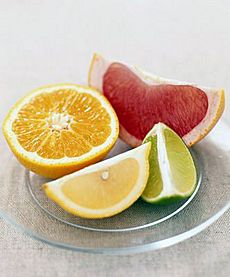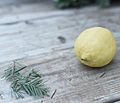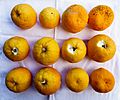Citrus facts for kids
Quick facts for kids Citrus |
|
|---|---|
 |
|
| Slices of various citrus fruits | |
| Scientific classification | |
| Kingdom: | |
| Division: | |
| Class: | |
| Subclass: | |
| Order: | |
| Family: | |
| Subfamily: |
Aurantioideae
|
| Genus: |
Citrus
|
|
Important species: Important hybrids: |
|
| Synonyms | |
|
Eremocitrus |
|
Citrus is a group of flowering trees and shrubs. They belong to the rue family, called Rutaceae. These plants grow delicious citrus fruits.
Some well-known citrus fruits include oranges, lemons, grapefruit, and limes. These fruits are important crops around the world. Scientists believe citrus fruits first came from places like Australia, New Caledonia, and New Guinea. Other experts think they started in parts of Southeast Asia. This is where many popular types like oranges and lemons first grew. People have been growing citrus fruits for a very long time.
Contents
Where Do Citrus Fruits Come From?
For a long time, people thought citrus plants grew naturally in Asia, Europe, or Florida. But it turns out, many of these ideas were not quite right.
The Journey of Citrus Fruits
The first European oranges, like the bitter orange, came from India. They were brought to Europe around the time of Alexander the Great. The oranges found in Florida were actually brought by Spanish explorers called Conquistadors. Lemons arrived in Europe during the time of ancient Rome.
How Citrus Fruits Changed Over Time
Today's large citrus fruits actually started as small, edible berries. They slowly changed over millions of years. All the common citrus fruits we eat today, like sweet oranges and lemons, were created by crossing different original species. This happened over the last few thousand years.
Citrus fruits are famous for their amazing smell. This comes from special parts in their rind called flavonoids and limonoids. Most citrus fruits are also very juicy. Their juice has a lot of citric acid, which gives them their sharp, tangy taste. Many citrus fruits are grown to be eaten fresh. They are also used to make juice, marmalades, and pickles.
Citrus fruits are also a great source of vitamin C and other helpful plant compounds. The amount of vitamin C in a fruit can depend on its type and how it was grown. Fruits grown organically often have more vitamin C.
How We Use Citrus Fruits
Cooking and Eating Citrus
Many citrus fruits are eaten fresh. These include oranges, tangerines, grapefruits, and clementines. You can usually peel them easily and split them into sections. Grapefruit is often cut in half and eaten with a spoon. Orange and grapefruit juices are also very popular drinks for breakfast.
More sour citrus fruits, like lemons and limes, are usually not eaten on their own. However, Meyer lemons can be eaten because they are both sweet and sour. People often make lemonade or limeade by mixing their juice with water and sugar. Lemons and limes are also used to decorate food or in cooked dishes. Their juice is a common ingredient in salad dressings. It is also squeezed over cooked meat or vegetables.
The outer skin of citrus fruits, called the rind, can be very bitter. This is especially true when it's cooked. So, it's often mixed with sugar. The soft inside part of the fruit, called the fruit pulp, can be sweet, tart, or very sour. Marmalade is a spread made from cooked oranges and lemons. It can be quite bitter, but it's usually sweetened to make it taste like jam. Lemon or lime slices are often used to add flavor to water, soft drinks, or other beverages. The colorful outer part of the peel, called zest, is used to add flavor in cooking. The white inner part of the peel, called the pith, is usually avoided because it's bitter.
Health Benefits of Citrus
Oranges were historically very important for their high amount of vitamin C. Vitamin C helps prevent a disease called scurvy. Scurvy happens when someone doesn't get enough vitamin C. Just 10 milligrams of vitamin C a day can prevent it. Feeling tired is an early sign of scurvy. If not treated, it can lead to bleeding and easy bruising. British sailors on long trips were given citrus fruits to stop them from getting scurvy. This is why British sailors were sometimes called "Limeys."
Citrus fruits also contain something called Pectin. Pectin is a natural substance found in plant cell walls. Limes, lemons, oranges, and grapefruits have a lot of pectin. Lemons have the most citrate, which is another helpful compound, compared to other citrus fruits.
List of Common Citrus Fruits
- Clementine
- Grapefruit
- Kumquat
- Lemon
- Rough Lemon
- Lime
- Kaffir lime
- Key lime
- Leech Limes
- Mandarin orange
- Minneola
- Orange (fruit)
- Pomelo
- Satsuma
- Shonan gold
- Sweety
- Tangerine
- Tangelo
- Ugli
- Imperial Lemon
- Citron
- Red finger lime
- Amanatsu
- Orangelo
- Oroblancho
- Tangor
- Etrog
- Blood orange
Images for kids
-
Limes in a grocery store
-
Mediterranean Mandarin (Citrus ×deliciosa plantation, Son Carrió (Mallorca)
-
Orangery of the Botanical Garden in Leuven (Belgium)
-
Citrons (Citrus medica) for sale in Germany
-
Red finger Lime (Citrus australasica), a rare delicacy from Australia
-
Sweetie or oroblanco is a pomelo-grapefruit hybrid.
-
Clementines (Citrus ×clementina) have thinner skins than oranges.
-
Mikan (Citrus ×unshiu), also known as satsumas
-
Calamansi, a ubiquitous part of traditional dipping sauces and condiments in Philippine cuisine
-
Ripe bitter oranges (Citrus × aurantium) from Asprovalta
See also
 In Spanish: Cítricos para niños
In Spanish: Cítricos para niños
























